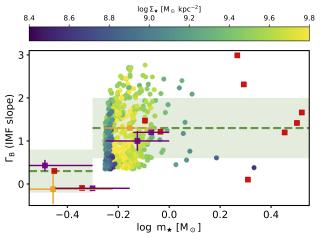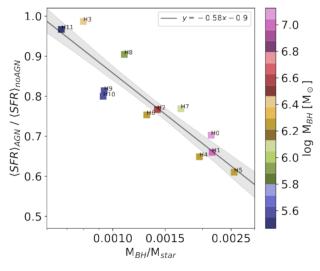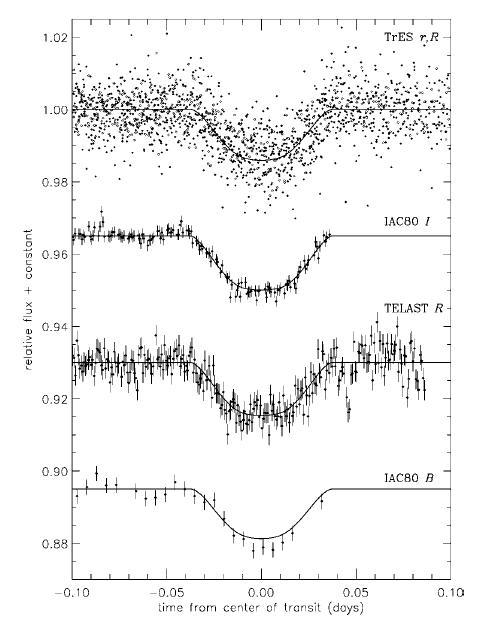In August 2006 a new planetary transit was discovered from data from the TrES network. The discovery was confirmed using radial velocity curves obtained with the Keck and characterised with light curves in different filters obtained using two telescopes at the Observatorio del Teide: "IAC80" and "TELAST" (the first result of scientific interest obtained from the latter). The planet discovered, TrES-2, is more massive and somewhat larger than its quasi-homonym TrES-1 (the first exoplanet discovered using the transit method), and follows the expected patterns for this type of object. Its main importance is that it is the first object discovered in the area of observation of the future Kepler satellite, which will be able to track it in a degree of detail never before achieved.
Light curves of TRES_2 obtained using telescopes of the network and with two telescopes from the Observatorio del Teide: "IAC-80" and "TELAST" with different filters.
Advertised on
It may interest you
-
 The universality of the stellar initial mass function (IMF) is one of the most widespread assumptions in modern Astronomy and yet, it might be flawed. While observations in the Milky Way generally support an IMF that is invariant with respect to the local conditions under which stars form, measurements of massive early-type galaxies systematically point towards a non-universal IMF. To bridge the gap between both sets of evidence, in this work we measured for the first time the low-mass end of the IMF from the integrated spectra of a Milky Way-like galaxy, NGC3351. We found that the slope ofAdvertised on
The universality of the stellar initial mass function (IMF) is one of the most widespread assumptions in modern Astronomy and yet, it might be flawed. While observations in the Milky Way generally support an IMF that is invariant with respect to the local conditions under which stars form, measurements of massive early-type galaxies systematically point towards a non-universal IMF. To bridge the gap between both sets of evidence, in this work we measured for the first time the low-mass end of the IMF from the integrated spectra of a Milky Way-like galaxy, NGC3351. We found that the slope ofAdvertised on -
 Despite the fundamental role that dark matter halos play in our theoretical understanding of galaxy formation and evolution, the interplay between galaxies and their host dark matter halos remains highly debated from an observational perspective. This lack of conclusive observational evidence ultimately arises from the inherent difficulty of reliably measuring dark matter (halo) properties. Based on detailed dynamical modeling of nearby galaxies, in this work we proposed a novel observational approach to quantify the potential effect that dark matter halos may have in modulating galaxyAdvertised on
Despite the fundamental role that dark matter halos play in our theoretical understanding of galaxy formation and evolution, the interplay between galaxies and their host dark matter halos remains highly debated from an observational perspective. This lack of conclusive observational evidence ultimately arises from the inherent difficulty of reliably measuring dark matter (halo) properties. Based on detailed dynamical modeling of nearby galaxies, in this work we proposed a novel observational approach to quantify the potential effect that dark matter halos may have in modulating galaxyAdvertised on -
 Recent observational studies suggest that feedback from active galactic nuclei (AGNs)—the energetic centres powered by supermassive black holes—may play an important role in the formation and evolution of dwarf galaxies, contrary to the standard thought. We investigated this using two sets of 12 cosmological magnetohydrodynamic simulations of the formation of dwarf galaxies: one set using a version of the AURIGA galaxy formation physics model including AGN feedback and a parallel set with AGN feedback turned off. Our results reveal that AGNs can suppress the star formation (SF) of dwarfAdvertised on
Recent observational studies suggest that feedback from active galactic nuclei (AGNs)—the energetic centres powered by supermassive black holes—may play an important role in the formation and evolution of dwarf galaxies, contrary to the standard thought. We investigated this using two sets of 12 cosmological magnetohydrodynamic simulations of the formation of dwarf galaxies: one set using a version of the AURIGA galaxy formation physics model including AGN feedback and a parallel set with AGN feedback turned off. Our results reveal that AGNs can suppress the star formation (SF) of dwarfAdvertised on
